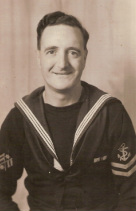~ Chapter Nineteen ~
A New Family, Another War
When he returned to Margate in 1929, Tom took a job with the Post Office. At the same time, he joined the Royal Naval Reserve, hence maintaining his association with the Navy, the only life he had known since he was a fifteen year-old boy.
Soon after his return, he met a local girl by the name of Gwendoline Sutton. Gwen was some ten years younger than Tom and was working as a waitress at the time. It wasn’t long before she and Tom began a family. Their first child, Anthony, was born in Margate in May 1933. Their second, Pamela, followed in May 1934.
In that same year, having completed fifteen years of reckonable service from the age of eighteen, Tom was awarded the Royal Navy’s Long Service and Good Conduct Medal.
Then Tom began working for the Admiralty in central London and the family moved more than fifty miles inland to Sidcup, a suburb in the south-east of London, to be closer to his job. Their new home was a recently built three-bedroom terraced house in Brookend Road. The address was only a few miles from the Admiralty buildings at the Royal Arsenal on the south bank of the River Thames in Woolwich, where Tom would be transferred a few years later.
It was in Sidcup that Tom and Gwen’s third child, Michael, was born in November 1939. But Tom may not have been present for the arrival of his latest son. Another “great war”, one that threatened to be even bigger and more devastating than the last, had erupted two months earlier. As a Reservist, forty year-old Tom was one of the first of millions of British civilians to be called up to fight in that war.
While we don’t have full details of Tom’s Second World War service record, we do know that in 1939 he returned to Scapa Flow, the scene of the scuttling of the German High Fleet more than twenty years earlier, where this time he was Leading Signalman on a naval trawler. We also know that his last posting before the War ended in 1945 was to Iceland. These are very strong indications that for the duration of the War Tom served in the Royal Naval Patrol Service. Here is the Wikipedia description of that service:
Soon after his return, he met a local girl by the name of Gwendoline Sutton. Gwen was some ten years younger than Tom and was working as a waitress at the time. It wasn’t long before she and Tom began a family. Their first child, Anthony, was born in Margate in May 1933. Their second, Pamela, followed in May 1934.
In that same year, having completed fifteen years of reckonable service from the age of eighteen, Tom was awarded the Royal Navy’s Long Service and Good Conduct Medal.
Then Tom began working for the Admiralty in central London and the family moved more than fifty miles inland to Sidcup, a suburb in the south-east of London, to be closer to his job. Their new home was a recently built three-bedroom terraced house in Brookend Road. The address was only a few miles from the Admiralty buildings at the Royal Arsenal on the south bank of the River Thames in Woolwich, where Tom would be transferred a few years later.
It was in Sidcup that Tom and Gwen’s third child, Michael, was born in November 1939. But Tom may not have been present for the arrival of his latest son. Another “great war”, one that threatened to be even bigger and more devastating than the last, had erupted two months earlier. As a Reservist, forty year-old Tom was one of the first of millions of British civilians to be called up to fight in that war.
While we don’t have full details of Tom’s Second World War service record, we do know that in 1939 he returned to Scapa Flow, the scene of the scuttling of the German High Fleet more than twenty years earlier, where this time he was Leading Signalman on a naval trawler. We also know that his last posting before the War ended in 1945 was to Iceland. These are very strong indications that for the duration of the War Tom served in the Royal Naval Patrol Service. Here is the Wikipedia description of that service:
|
|
The RNPS fleet was highly vulnerable to German mines, as well as to attacks by aircraft, U-boats and submarines. Of approximately 1,600 craft manned by the RNPS, some 260 were lost in action in the course of the War. Over 15,000 RNPS seamen were also killed during that period, including nearly 2,400 with “no known grave but the sea”. It is very clear, therefore, that Tom did not have an easy War. However, any fears that he may have had about his safety are not evident in this photograph of him, taken in 1940.
Tom was demobbed in 1945. Having participated in and emerged unscathed from two World Wars, he was finished with the Navy at long last. |
